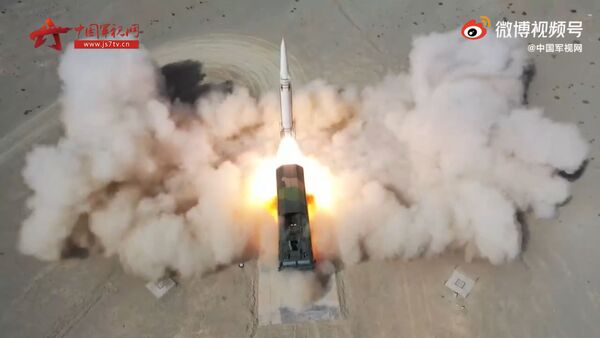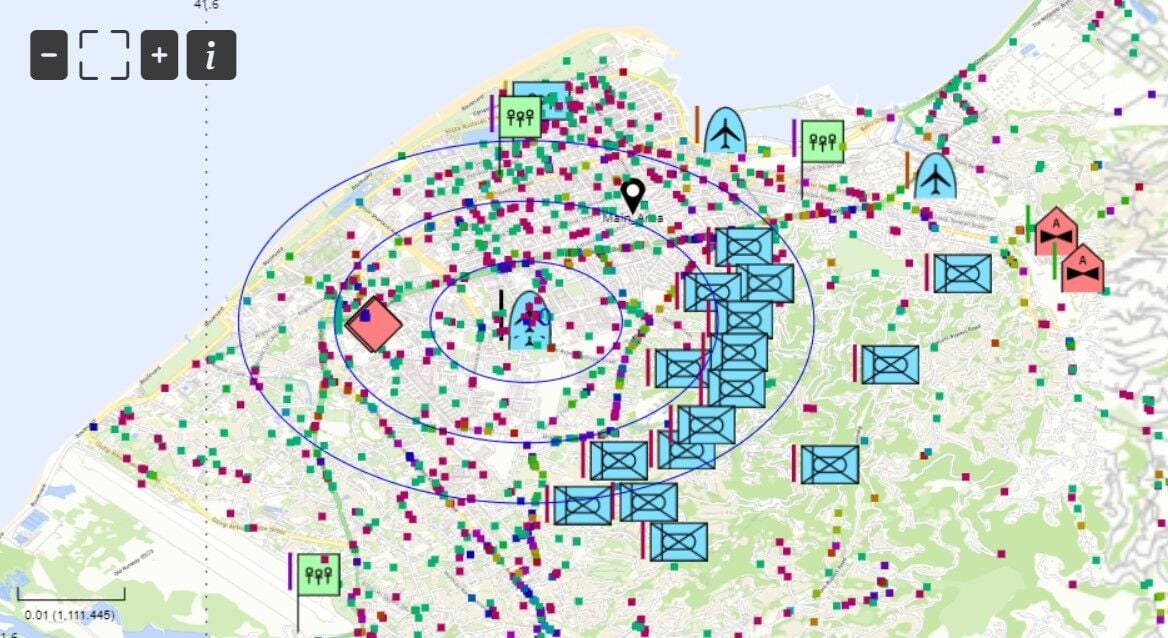- About
- Intara
- Capabilities
- Advisory
- Resources
- News
- Store
China unveils improved short-range ballistic missile
23 August 2021
by Andrew Tate
Chinese state-owned media reported on 21 August that the People's Liberation Army Rocket Force (PLARF) successfully conducted live firings of what it described as two new conventionally armed short-range ballistic missiles (SRBMs).
Video footage released by China Central Television (CCTV) appears to show that the carrier rocket used in the firings was a Dong Feng 15 (DF-15; also known as a CSS-6 by the US Department of Defense), with the media outlet indicating that it was fitted with a new or modified warhead.

A screengrab from footage released by CCTV on 21 August showing what the media outlet described as one of two new conventionally armed ballistic missiles being launched by a PLARF brigade from a TEL vehicle located at a desert region in northwestern China. (CCTV)
The missiles were launched from a desert location in northwestern China and flew for “hundreds of kilometres”, noted CCTV, adding that the weapons were operated by troops from the PLARF's 1st Conventional Missile Brigade and transported to the launch site on four-axle, wheeled transporter-erector-launchers (TELs).
DRDO test-fires ‘Indigenous Technology Cruise Missile'
18 April 2024
by Kapil Kajal


The ITCM (pictured above from its test on 18 April) is a technology demonstrator programme to validate the capability of small turbofan engines. (Indian Ministry of Defence)
India's state-owned Defence Research and Development Organisation (DRDO) test-fired its ‘Indigenous Technology Cruise Missile (ITCM)' from the Integrated Test Range (ITR) in Chandipur off the northeastern coast of Odisha, the Indian Ministry of Defence (MoD) said in a press release on 18 April.
“During the test, all subsystems performed as per expectation and the missile performance was monitored by several range sensors like radar, electro optical tracking system (EOTS), and telemetry deployed by [the] ITR at different locations to ensure complete coverage of the flightpath,” the MoD said.
The flight of the missile was also monitored from the Su-30-MKI aircraft of the Indian Air Force, the MoD added.
The missile followed the desired path using “waypoint navigation and demonstrated very-low-altitude sea-skimming flight”, according to the MoD.
“This successful flight test has also established the reliable performance of the indigenous propulsion system developed by the Gas Turbine Research Establishment (GTRE), Bengaluru,” the MoD said.
Hadean, 4C Strategies integrate products to reduce training burden
18 April 2024
by Giles Ebbutt


A screenshot of the Hadean POLI constructive simulation displayed through the 4C Strategies Exonaut training management software. (Hadean)
Hadean and 4C Strategies have successfully integrated a constructive simulation with Exonaut exercise management software, utilising Hadean's spatial computing platform.
The integrated solution, displayed at the International Training Technology Exhibition & Conference (IT²EC) 2024 in London, enabled Hadean's Pattern of Life Indicator (POLI) constructive simulation to be controlled from within 4C Strategies Exonaut software.
Exonaut is widely used in the UK and NATO as an exercise management tool, while constructive simulation is fundamental to effective command and staff training. Integrating the two previously separate functions offers the potential to improve training.
Explaining the integration, Paul Steel, UK military sales director for 4C Strategies, told Janes
US lawmakers grill US Navy officials on proposed shipbuilding budget
18 April 2024
by Michael Fabey


US lawmakers question the US Navy request to fund only one Virginia-class submarine (pictured) in fiscal year 2025. (Janes/Michael Fabey)
Members of the House Armed Services Seapower and Projection Forces Subcommittee raised concerns about the proposed US Navy (USN) plan to pare down key shipbuilding programmes on 17 April during the subcommittee hearing on the USN's Fiscal Year (FY) 2025 budget request.
While the USN – as was the case with the rest of the Pentagon – was charged with keeping a lid on costs, lawmakers said they felt the USN went too far with some major programmes.
Connecticut Congressman and ranking member of the Seapower and Projection Forces Subcommittee, Joe Courtney, set the tone with his opening statement.
“The Fiscal Responsibility Act (FRA), which [was] passed in May 2023 to avert a default on the full faith and credit of our nation's currency and bonds, mandated a 1% increase in the Department of Defense's budget request for fiscal year 2025,” Courtney said.
Chinese state-owned media reported on 21 August that the People's Liberation Army Rocket Force (PLAR...
Latest Podcasts
Iran Israel analysis
In this podcast Janes analysts discuss the Iranian attacks on Israel on the 14 April. They highlight the military systems used by Iran and the performance and impact of these on Israel. They also discuss the implications of this attack goi...
Listen nowJanes Case Studies
Using Janes Intara to build a common intelligence picture: Russian build up on the Ukrainian border
View Case StudyNews Categories
 Weapons Details
Weapons Details